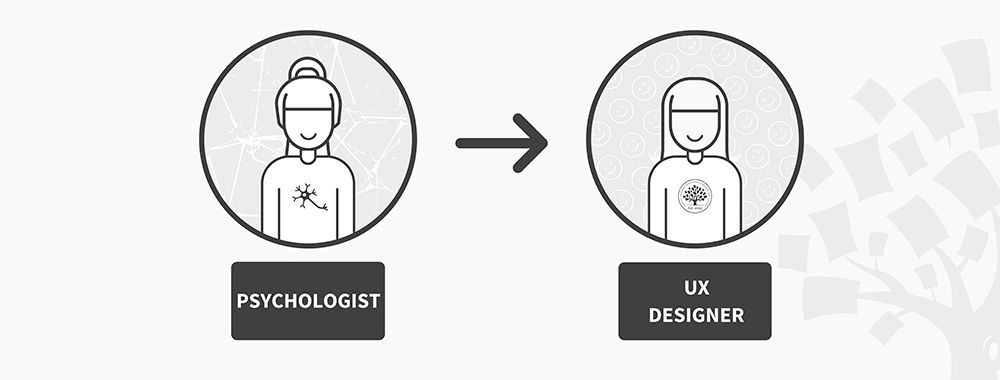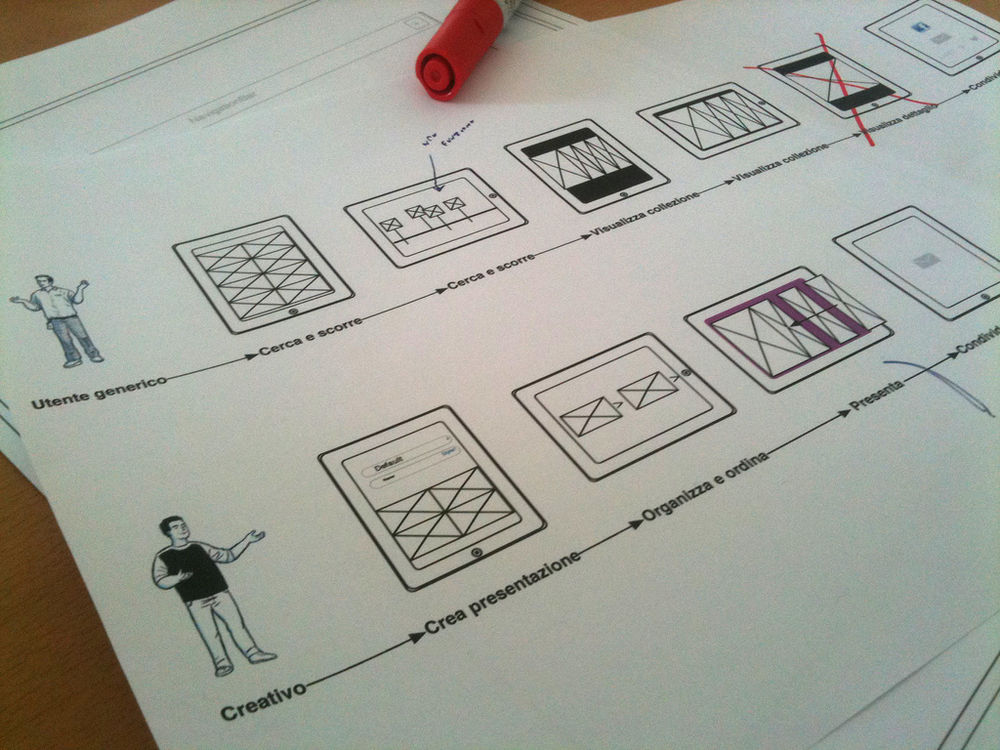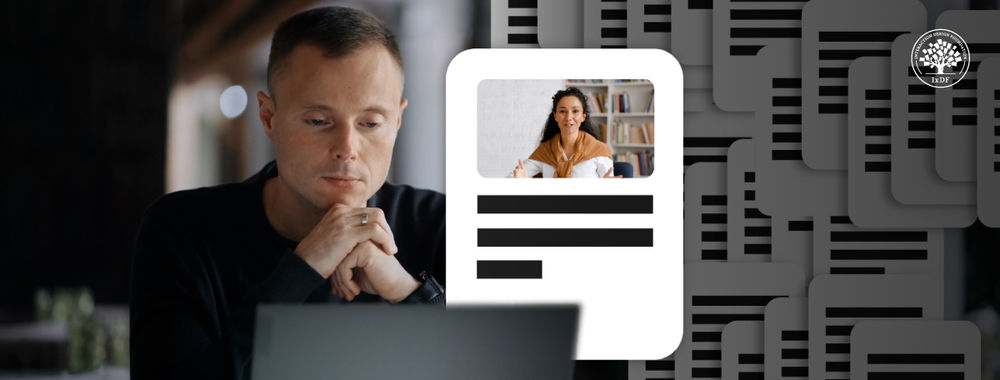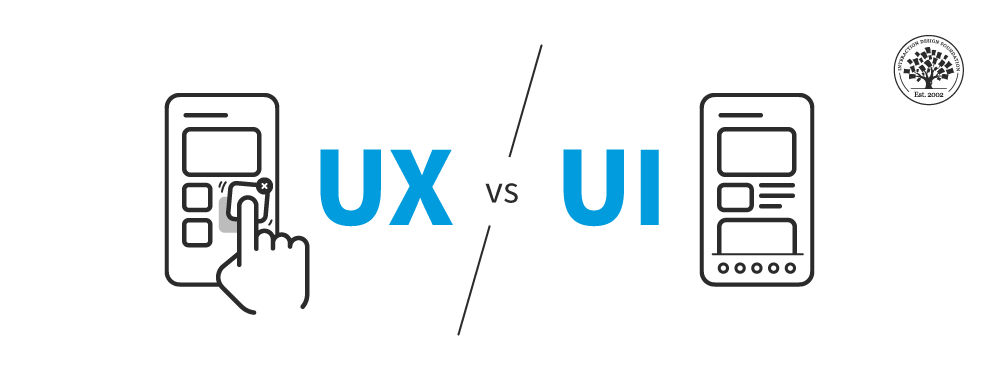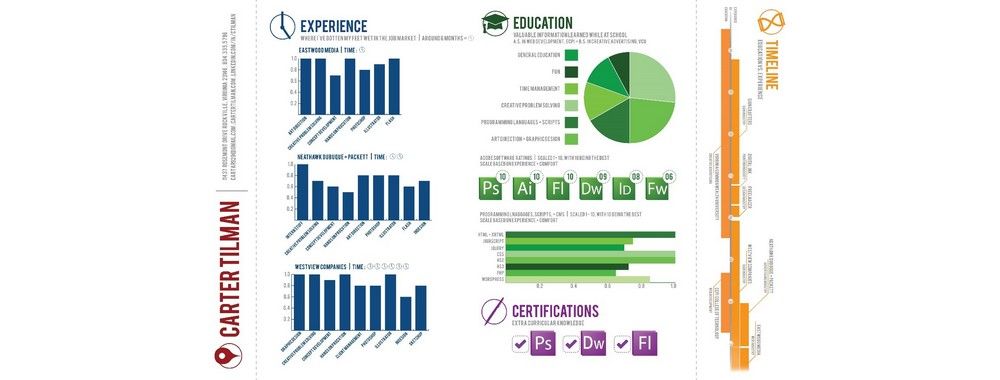Do you have a psychology degree, or are you in the process of getting one? Then, user experience (UX) design might be the career choice that no one told you about. Many people believe that psychology graduates’ only choices are to become therapists, HR specialists or researchers. While these career options can also be exciting, maybe they are not the best fit for you. If you’re looking for a career path that combines science and art, UX might be what you really want.
Meet Luigi Cotini, an Italian psychologist who moved to UX:
“When I was attending university, 99% of my classmates wanted to become psychotherapists or land a job in HR; those were things that I certainly took into consideration too, but at the same time they did not ignite the spark in me [...]
I wanted to find an innovative and uncommon job, where I could express my creativity in a practical way and where my psychology background would have been useful in some way.”
— Luigi Cotini
If, like Luigi, you’re a psychologist considering a career change to UX design, you’re in the right place. You already have the advantage of knowing the human mind inside out and thus, instead of changing your career from psychology to UX design, you can think about it as a progression. What additional skills do you need to learn to become a UX designer? Let’s find out.
“A designer who doesn’t understand human psychology is going to be no more successful than an architect who doesn’t understand physics.”
— Joe Leech, UX Consultant & Author of book Psychology of Designers
What Are User Experience and User Experience Design?
Show
Hide
video transcript
- Transcript loading…
User experience encompasses everything related to how a user interacts with a product, system or service, from how they feel to what they think about it.
As a psychologist, the word “product” might scare you. However, the first thing you should know about UX is that the term “user experience” was first coined in 1993 by the cognitive scientist Don Norman. Therefore, if a cognitive scientist coined the term, you can rest assured that your background in psychology will come in handy! In fact, according to the User Experience Careers 2019 report by the Nielsen Norman group, 23% of UX researchers have a degree in sociology or psychology.
“We must design for the way people behave, not for how we would wish them to behave.”
― Donald A. Norman, Living with Complexity
The job of a UX designer is to create products, systems or services that deliver the best possible user experience, considering three primary factors: the look, the feel and the usability of a product.
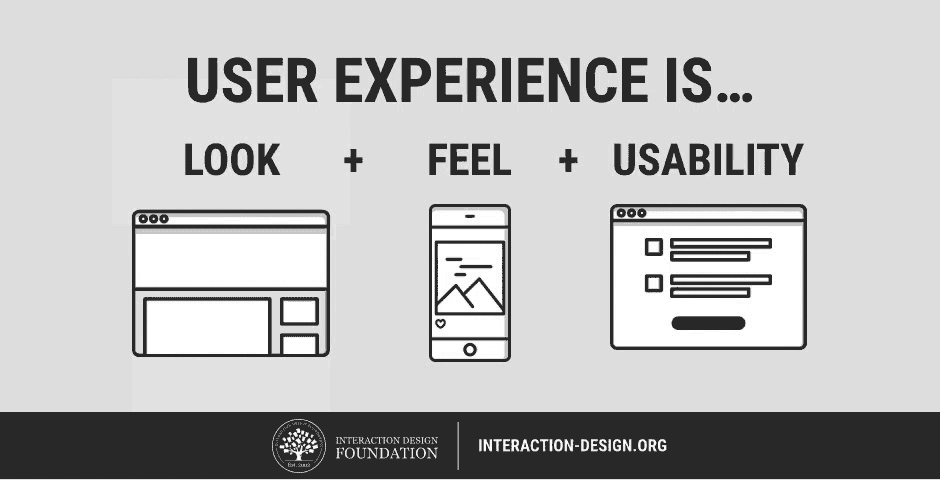
Imagine you go shopping for a new coat. You enter a shop and spot one particular coat that looks beautiful—it has visual appeal. Immediately you try it on. It feels incredibly soft and warm—it is a joy to put on. Lastly, you button it up with ease and realize you can comfortably put your stuff in the pockets, which have a zipper to make sure nothing falls out of them—it has excellent functionality and meets your needs. This example represents an ideal user experience with all its ingredients. However, has this ever happened to you? It’s more common to try on a coat that doesn’t fit right, or a coat that looks beautiful but is not warm enough, etc. The truth is that we live in a world full of inefficient and frustrating design, and as a UX designer, you can impact and improve the experiences of millions of people around the globe.
For instance, think of a disease that requires daily management such as diabetes. Some diabetes patients need to monitor their blood sugar levels and take medication every day. The consequences of forgetting to check their levels or take their medication could be life-threatening. Imagine they download an app with the hope that it will make their lives easier and to feel safer. They open the app, and it looks great, it makes it easier for them to manage their disease, and even motivates them thanks to a gamified experience. They feel safer, less anxious and more motivated. Now, what if instead of this experience, the app was difficult to use and it made it even harder to manage their disease? As a UX designer, it would be your job to take on this sort of challenge and work your way towards creating the best possible experience for your users. The world needs more UX designers in the digital field and everywhere.
As a psychologist, you probably have a deep desire or a profound sense of purpose to help people. As a UX designer, you’ll be able to apply human-centered design—or humanity-centered design—principles not only to products but also to tackle complex global challenges.
What Do Psychology and UX Design Have in Common?
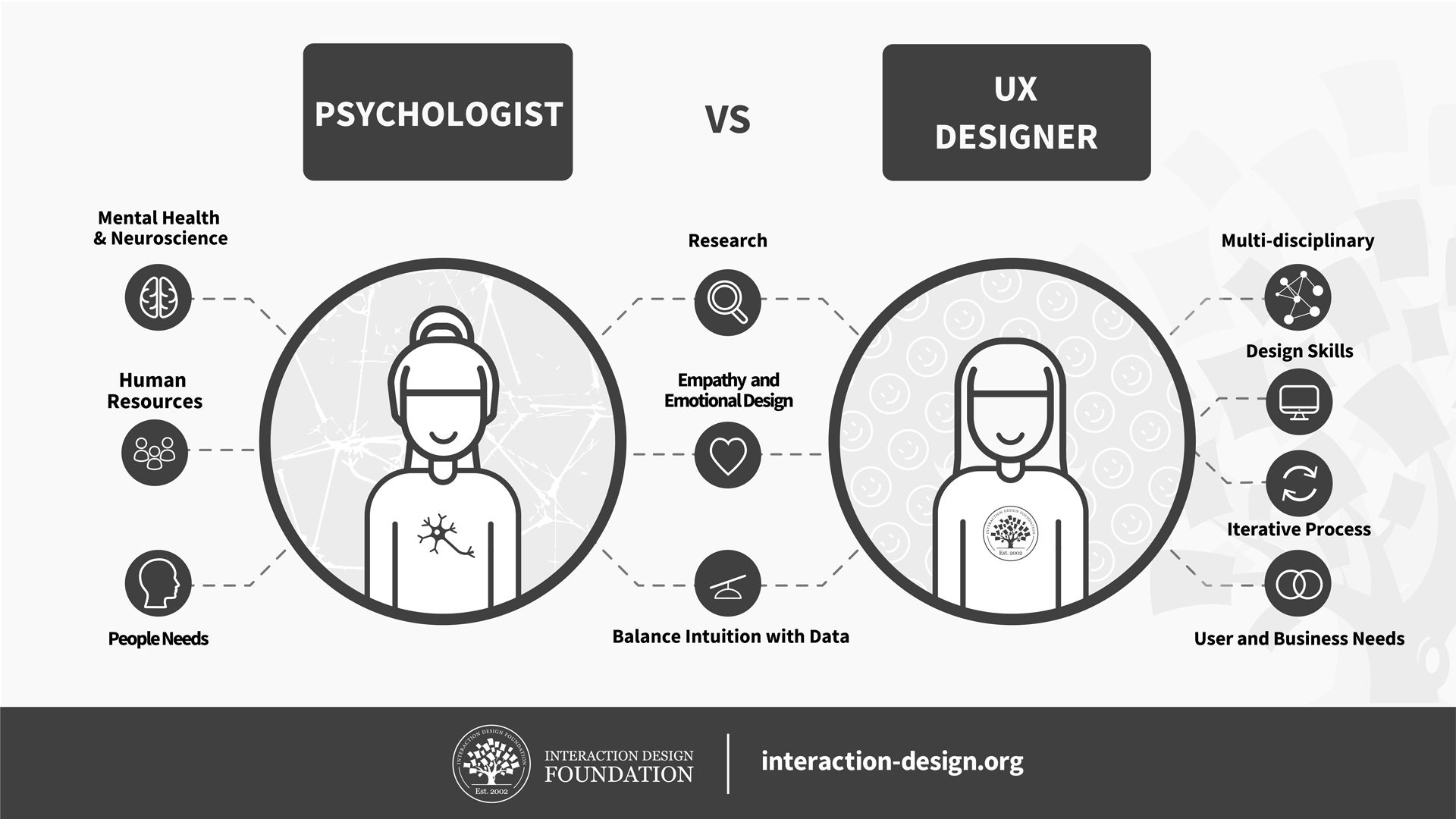
Research
The UX design process starts with research to determine users’ motivations and needs. As a psychologist, you already know that people don’t always say what they mean. So, you need to use specific techniques to gather significant data and extract relevant insights. These techniques include interviews, focus group discussions, surveys, and many more. The good news is that you’re probably already familiar with most of them. Also, your knowledge of the scientific method will allow you to interpret the data the right way and draw helpful insights to fuel the design process.
Empathy
People tend to think that empathy is an innate trade. However, psychologists like you spend years training their empathy. The ability to step out of your mental models and put yourself in your user’s shoes will serve you well in UX design. To create a successful user experience, it is essential to center the process around the users’ needs and to overcome any implicit or explicit bias. What do your users need? How can you help them achieve it? What is the root problem you should solve?
In UX design, the practice of empathy will allow you to create the best solutions to your users’ problems and not only cover their needs but also create solutions that are a joy to use—removing any unnecessary friction or pain.
Emotional Design
As Don Norman said:
“Cognition attempts to make sense of the world: emotion assigns value.”
― Donald A. Norman, The Design of Everyday Things
You’re already familiar with the essential role of emotions in decision-making processes. Furthermore, you’re aware of context and culture’s importance in shaping subjective experiences. In UX, you’ll be concerned with users’ emotional journeys when interacting with a product, service, or system. When conducting user interviews and usability testing, you’ll be able to leverage your psychology background to identify how users feel when interacting with a product. In addition, you’ll have to master the design tools used to elicit emotions, such as color, typography, content curation, etc.
Balance Intuition with Data

Sometimes people don’t mean what they say and the same thing happens with data. It may look like one thing but actually, be the other. This is why extracting insights from data—especially Big Data—is almost an art. From your research experience, you know how to properly analyze data to get significant and reliable results.
At the same time, data alone sometimes falls short due to the complexity of human nature. As a psychologist, you know how to add your intuition and knowledge about the human mind and behavior into the equation to develop hypotheses that can be tested. This combination of intuition balanced with data will give you an edge as a UX designer.
The Differences between Psychology and UX Design
Multi-disciplinary
If you’re a therapist who is used to seeing patients in your private practice, you’ll need to get used to working in a multi-disciplinary team. However, if you have worked as a researcher at some point in your career, you’re already familiar with the dynamic of working with people from different backgrounds.
You’ll need to learn about the various roles in a team and the product development lifecycle to be able to communicate efficiently with team members and stakeholders.
Design Skills
As a psychologist, you use different methods to help your patients achieve their mental health goals. As a UX designer, you’ll need to master a new set of tools to help your users, including the use of color, typography, layout, interaction design, writing, etc. What’s more, you’ll need to learn how to develop user personas and how to work with wireframes and prototypes.
Iterative Process
The iterative nature of the design process might be one of the hardest things to get used to for someone with a psychology background. To a certain extent, scientific research tends to be very well-planned and sequential. Think of a clinical trial for a new drug; it would probably start with phase I (safety studies on healthy volunteers), then phase II and phase III (safety and efficacy studies), and then phase IV (long-term effects studies). In this case, you would never move on to the next phase if you hadn’t succeeded at the previous one. Well, in UX, you’ll need to embrace the so-called design squiggle.
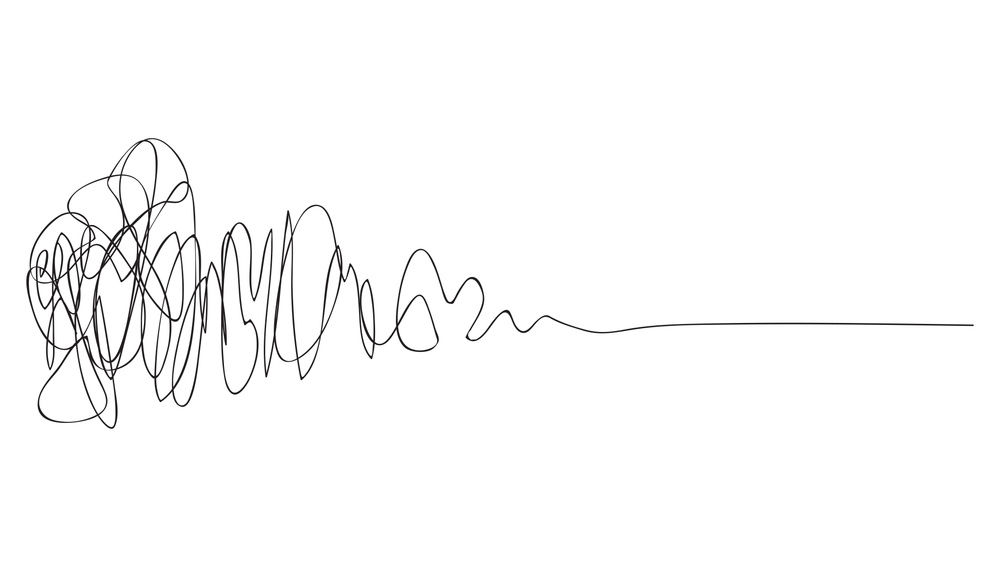
The design process isn’t a straight line. It’s a messy squiggly process that you must endure to gain clarity about the right problems to work with.
As a UX designer, your journey will be of the iterative kind. It will involve doing research, uncovering insights, testing them out, uncovering more insights and then starting again. Nothing is set in stone, and in every iteration, you’ll learn something new and tweak what you already had. It doesn’t matter how long a design team has to develop a product; results will only seem to emerge 24 hours before the deadline.
Changing People’s Behavior vs Tailoring Solutions to Current Behavior
If you’re a therapist or a mental health professional, your focus might be to help people to transform their current behavior to achieve better mental health and well-being. As a UX designer, you’ll observe and research their behavior to create the best possible solutions for their needs. In a sense, you’ll still work to improve their lives, but in a different way. You’ll focus on creating solutions that can cover their needs and bring more joy of use to their lives.
Imagine someone who is afraid of flying. The mere fact of going to the airport might be very anxiety-inducing. Then, they get to the airport and they can’t see the boarding gate because the screens are too small and there are many people gathered in front of them, which increases their anxiety even more. What if, instead of having many small screens the airport had installed fewer but bigger screens. Then, people wouldn’t have to get so close to the screen to be able to see their boarding gates; and that same person who was already feeling anxious would be a bit more relaxed since they can very easily see where they have to go. If you had been part of the UX team that made that decision, you would have contributed to helping that person lower their anxiety, and probably many more who were feeling the same way.
UX design has the power to help people—either directly or indirectly—by improving their day-to-day lives.
Show
Hide
video transcript
- Transcript loading…
Balancing User Needs with Business Needs
According to the Design Management Institute, design-driven companies outperform the S&P 500 by 219%. As a UX designer, you’ll have to consider that UX affects the bottom line. Therefore, you’ll need to balance users’ needs with the business needs. You’ll need to learn about the return on investment (ROI) of UX and get familiar with terms such as cost savings, revenue and other key performance indicators (KPIs).
“For every dollar spent to resolve a problem during product design, $10 would be spent on the same problem during development, and multiply to $100 or more if the problem had to be solved after the product’s release.”
— Robert Pressman, Software Engineering: A Practitioner’s Approach book
The Big Benefit of Psychology Experience when Moving to UX Design
Human-centric
The most significant benefit you’ll have as a psychologist moving to UX design is that you’ll have no problem putting users at the center of the design process. Your whole experience is about focusing on the person right in front of you and overcoming your own biases and preconceived notions to help them in the best way possible. This mindset is the cornerstone of being a UX designer. Know your users inside out and focus on their needs, not your own.
Challenging Assumptions
As someone trained in the scientific method, you know that there are no universal, simple truths, and thus, you need to use the tools at your disposal to get as close as possible. The dynamic hypothesis – counterhypothesis – new hypothesis will help you have a smooth transition into the design process. Furthermore, you know the importance of tackling the root problem instead of “treating the symptoms.” This approach will help you identify your users’ real needs, define the right problem to solve—which may be different from the problem statement you started the process with—and develop the best possible solution to deliver true value for them.
The Take Away
The common misconception is that one should have a background in design to become a UX designer. However, a background in psychology is already a considerable advantage on the way to becoming a UX designer. There is a lot of common ground between both fields. Many of your skills as a psychologist will transfer smoothly to a career in UX design, including your research experience, empathy abilities, and knowledge about human behavior and the human brain.
Your challenge will be to learn and master new techniques such as wireframing and prototyping and to become familiar with the design process. However, you have many options to enter the world of UX. Once you become more familiar with the design world, you’ll see the many ways you can leverage your psychology background to become an outstanding UX designer.
Where to Learn More
Online Courses
Interaction Design Foundation (IxDF)
With over 120,000 members (and counting), we’re proud to share that the Interaction Design Foundation is the world’s largest specialist design education community. According to Forbes Magazine, the IxDF provides an Ivy League-level of UX design education, and Don Norman referred to the IxDF as:
“A goldmine of information on interaction design”
— Don Norman, co-founder and Principal Emeritus of Nielsen Norman Group
Apart from the courses suggested in the learning path, we offer master classes to help you further develop your skills in UX design.
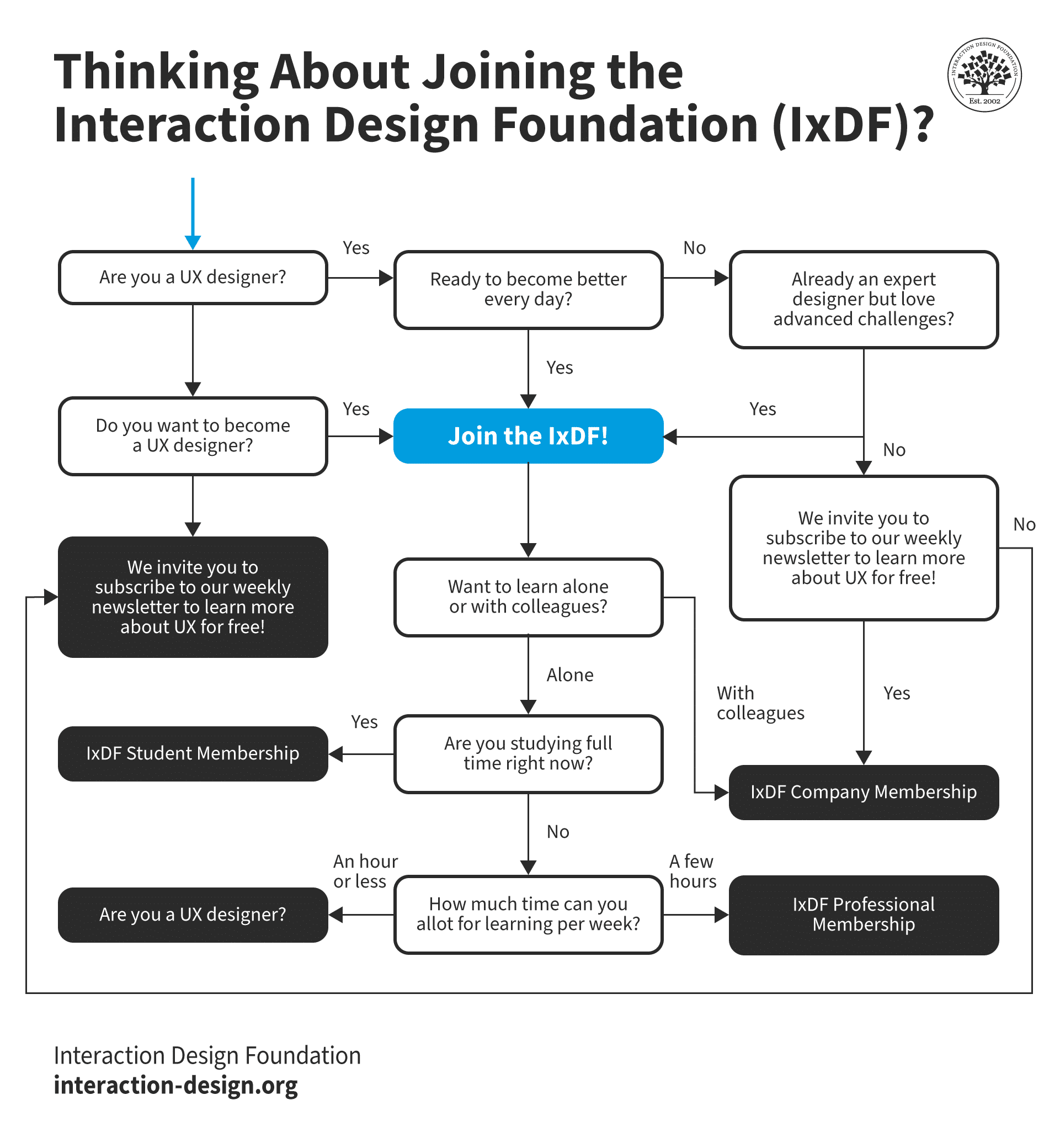
If you’re thinking about joining the IxDF, but don’t know where to start, follow this flowchart to find out which learning style might suit you best.
We take care to keep the courses updated and work towards adding more relevant topics so that you get the benefit of the latest research and methods. The best part about our platform: for a low annual membership fee, you get access to all of our courses for a year with no additional charges, along with access to our community.
Many people have used IxDF education to switch from psychology to UX. Luigi Cotini tells us how he changed his career thanks to the IxDF:
“I decided to totally devote myself to the acquisition of the skills that would allow me to work as a UX designer. So I started my membership with the IxDF, as it clearly seemed to be the best online school to learn UX design.”
Find Luigi’s full review here.
Raquel Talavera also explains to us her story:
“Thanks to this course I was able to better realize the valuable contributions of Cognitive Psychology to the field of Human-Computer Interaction. Another reason why I chose IxDF was because of its variety of courses with more specific topics that allow you to deepen theoretically in an area of interest, which in my case is Psychology. [...]
Although as a psychologist I knew several of the techniques that are usually used for user research (such as observation, contextual interviews, semi-structured interviews), I learned new ways to analyze information at a speed according to the pace of the market, for example through group thematic analysis.”
Read Raquel’s full story From Psychologist to UX Researcher: How did the Interaction Design Foundation courses help me?—A Review here.
Coursera
Coursera is another platform that offers courses on various subjects, including UX. Developed by a consortium of universities, the courses are of high quality. However, the fees for individual courses vary, and the courses tend to be offered at most once or twice a year, which may or may not suit your learning goals. If you’re not sure what platform might be better for you, find here a comparison between the Google UX design course on Coursera and IxDF courses.
Udemy
Udemy is the world’s largest marketplace for training. You can find thousands of courses across a wide range of topics. This extensive catalog comes from the community on the platform, which enables anyone to publish and sell a course. Unfortunately, as Udemy doesn’t design its courses, the quality of the courses can vary significantly from one to the next. Along with good courses, there are also several poor ones, and you’ll need to be wary of which course to purchase.
CareerFoundry
The CareerFoundry Bootcamp is one program, split into three courses: Intro to UX Design, UX Design Immersion and Specialization. You can either specialize in UX design, UI design or web development. CareerFoundry also offers courses in web development, UX design, UI design, and data analytics. However, CareerFoundry's UX Design course might be a bit steep in comparison with other online courses, and it has a fixed duration of 10 months (15-20 hours per week).
Classroom Courses
Nielsen Norman Group
If you prefer to learn in a classroom than learn online, you may want to visit the Nielsen Norman Group. The group has an excellent reputation and is one of the world’s most respected UX consultancies. Their certifications are based on attending conferences. However, the certifications are expensive. The location and timing of the live conferences can also become a challenge if they are not near you.
General Assembly
General Assembly offers immersive bootcamps in several disciplines, including UX design, both full-time and part-time. As with any classroom-based training, the price of their courses is steep. They also have a limited number of locations for you to physically attend the bootcamps, which may add to the cost of your education, should you need to travel.
University Courses
As you’re a working professional, we would not recommend that you take three or four years off to go back to university (and potentially take on debt). Moreover, most universities bundle UX with other disciplines and do not offer it in standalone courses. However, if you do wish to take a break, or have a specific learning path in mind which only a university course can fulfill, then here are some examples of what to expect in terms of curriculum and costs:
Carnegie Mellon – HCI Programs
York University – MSc in HCI Technologies
Given the significant investment in time as well as money (and perhaps relocation), you’ll want to research various options to identify the most suitable university and course. Find here an extensive list of UX-related Bachelor & Master Degrees.
To opt for a university education or not is an overwhelming decision. Make sure to check out our piece on Return on Investment of different design education approaches here, which may help you make a more informed decision.
